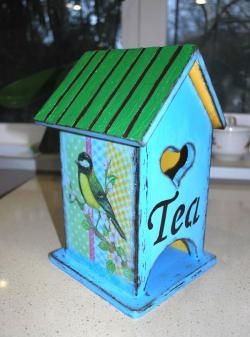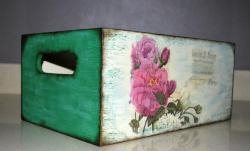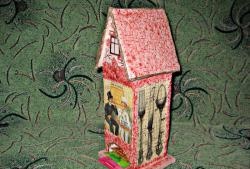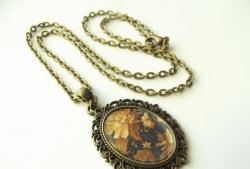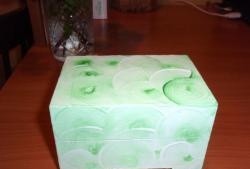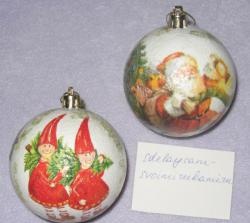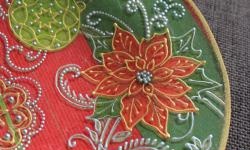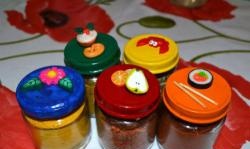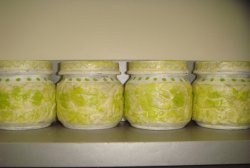Tea house in the Primitive style
Simplicity and conciseness are characteristic features of the Primitive style, which has recently been quite common in modern home decor. To create such an interesting element of kitchen decor as a Tea House, we will need the following:
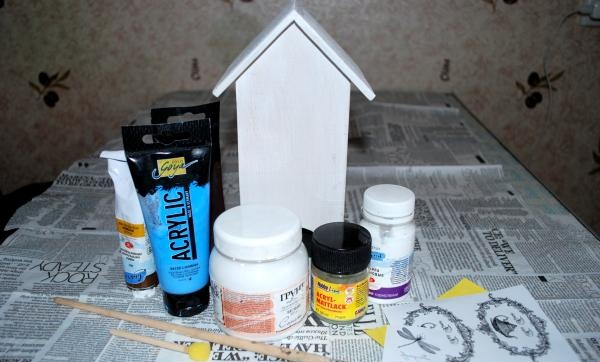
Before starting work with our house, it must be treated with white acrylic primer. Our workpiece was already sold primed, so all we had to do was sand it thoroughly with sandpaper to remove excess primer and level the surface. When decorating a product, we will use an interesting technique - aging the surface with a “dry brush”. To do this, it is necessary to create a lower contrasting layer: we paint our future tea house with brown paint.

After drying, go over it again with fine sandpaper.Apply blue paint, slightly diluted with water. An important point: apply the paint with a dry brush, carefully stretching it and rubbing it over the surface.
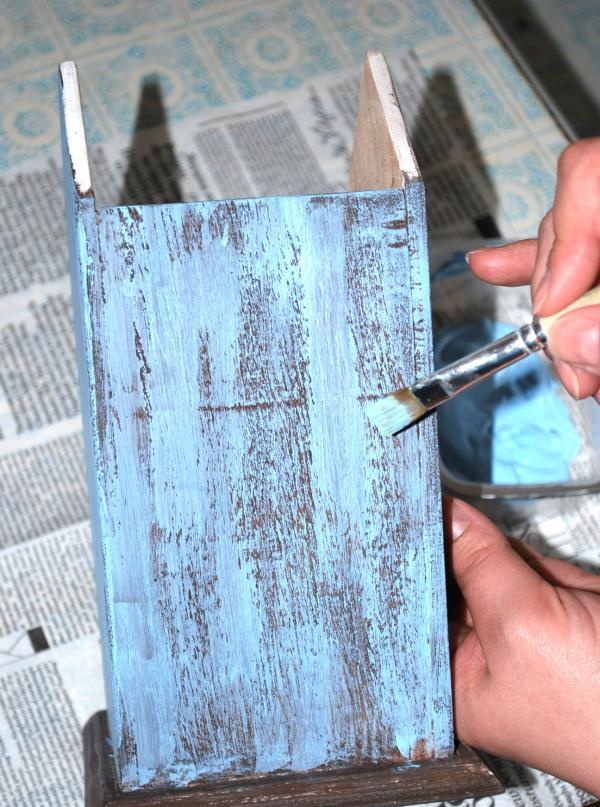
The paint dries quickly, so we additionally rub it with a hard sponge, evening out the strokes. Let's go over it again with fine sandpaper, making small abrasions. We will “implant” the printed black and white drawings into the surface “face into the varnish”. We cover the place where our drawing will be with acrylic varnish. We also varnish the front side of the printout and glue the printout.
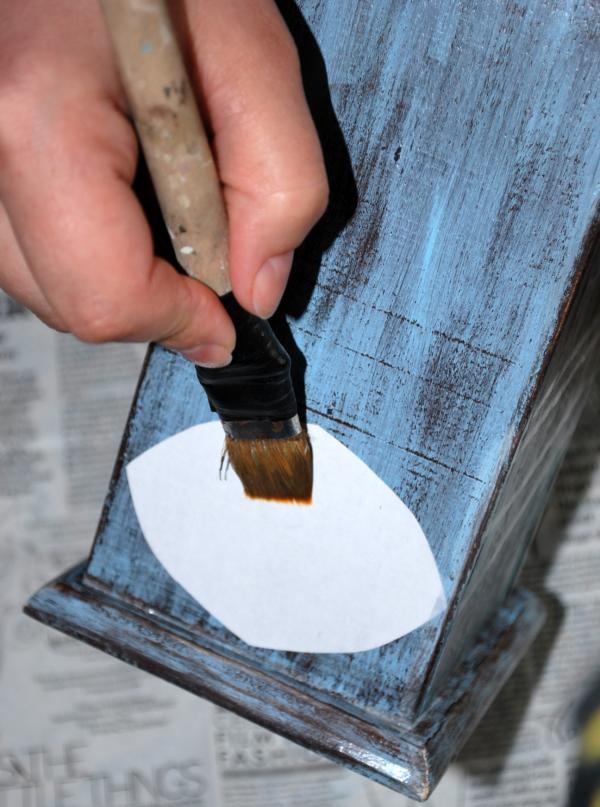
We firmly press the design onto the workpiece, smooth it out, expel all air bubbles, and glue it. For reliability, you can roll it with a rubber roller. After drying, the design from the print will be “transferred” in mirror image to the varnish. To develop the picture, you need to soak the paper with water: moisten a kitchen sponge with warm water and soak the picture with it. After soaking the paper, carefully roll up the top white layer until the black and white pattern appears. It is necessary to roll the paper away from the center very gently so as not to damage the design.
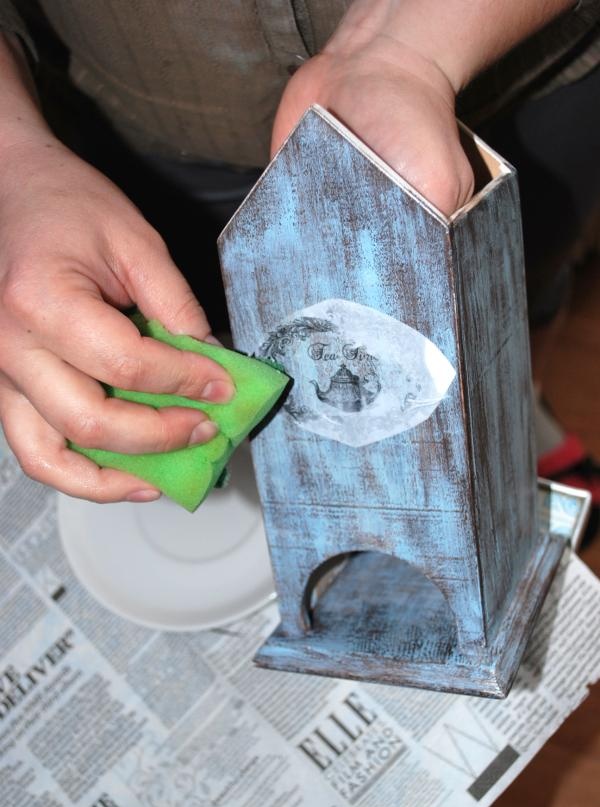
Let it dry. Do this manipulation several times: wet-roll-dry until all the remains of the paper are rolled up (no whitish traces remain). Let's dry it. For an additional “aging” effect, we will use burnt umber. To be able to correct possible mistakes and unsightly umber stains, before applying we cover the house with one protective layer of matte acrylic varnish. We will very carefully go over all the edges of the house with a sponge with umber applied. After the umber has dried, cover it with several layers (3-4) of matte varnish with intermediate drying.The final result of the work is shown in the photo.
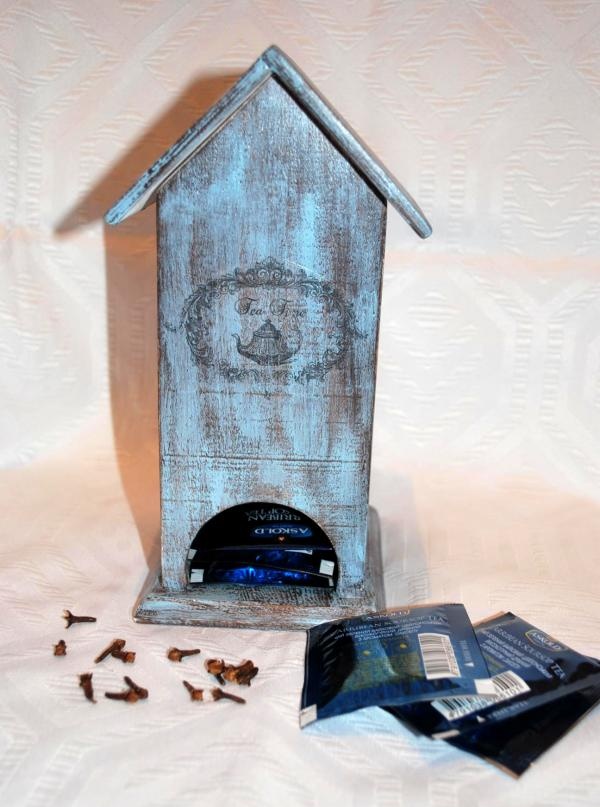

- wooden blank;
- black and white printout with the design we have chosen;
- artistic acrylic primer;
- acrylic paints for creativity (brown, white, sky blue, burnt umber);
- PVA stationery glue;
- acrylic varnish for finishing the product;
- brushes, foam sponges, sandpaper.

Before starting work with our house, it must be treated with white acrylic primer. Our workpiece was already sold primed, so all we had to do was sand it thoroughly with sandpaper to remove excess primer and level the surface. When decorating a product, we will use an interesting technique - aging the surface with a “dry brush”. To do this, it is necessary to create a lower contrasting layer: we paint our future tea house with brown paint.

After drying, go over it again with fine sandpaper.Apply blue paint, slightly diluted with water. An important point: apply the paint with a dry brush, carefully stretching it and rubbing it over the surface.

The paint dries quickly, so we additionally rub it with a hard sponge, evening out the strokes. Let's go over it again with fine sandpaper, making small abrasions. We will “implant” the printed black and white drawings into the surface “face into the varnish”. We cover the place where our drawing will be with acrylic varnish. We also varnish the front side of the printout and glue the printout.

We firmly press the design onto the workpiece, smooth it out, expel all air bubbles, and glue it. For reliability, you can roll it with a rubber roller. After drying, the design from the print will be “transferred” in mirror image to the varnish. To develop the picture, you need to soak the paper with water: moisten a kitchen sponge with warm water and soak the picture with it. After soaking the paper, carefully roll up the top white layer until the black and white pattern appears. It is necessary to roll the paper away from the center very gently so as not to damage the design.

Let it dry. Do this manipulation several times: wet-roll-dry until all the remains of the paper are rolled up (no whitish traces remain). Let's dry it. For an additional “aging” effect, we will use burnt umber. To be able to correct possible mistakes and unsightly umber stains, before applying we cover the house with one protective layer of matte acrylic varnish. We will very carefully go over all the edges of the house with a sponge with umber applied. After the umber has dried, cover it with several layers (3-4) of matte varnish with intermediate drying.The final result of the work is shown in the photo.


Similar master classes
Particularly interesting
Comments (0)

